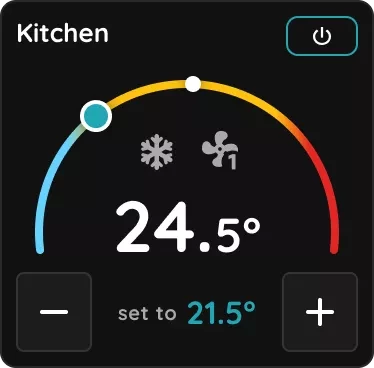On this page
The Pierre system, in combination with a temperature sensor, provides reliable on/off control for heating and cooling devices through its relay functionality. This simple yet effective setup allows Pierre to control a wide range of HVAC systems, functioning similarly to a traditional thermostat.
1. Direct Control of HVAC Devices:
• Pierre uses physical relays to directly control the on/off operation of HVAC units, ensuring that systems respond precisely to changes in temperature. This method does not rely on virtual control but rather on actual hardware integration.
2. Temperature-Based Automation:
• The temperature sensor monitors the ambient conditions, and based on the set temperature, Pierre turns the heating or cooling device on or off. This ensures the room stays at the desired comfort level efficiently.
3. Compatibility:
• With its on/off relay system, Pierre can manage a variety of HVAC devices, from simple heating systems to air conditioners, making it a flexible solution for both residential and commercial settings.
This setup provides a robust, hardware-based solution for HVAC control, functioning like a classic thermostat but with the added benefits of automation and integration into the Pierre system.


| Position | Wires | Diameter | Type | Comment |
|---|---|---|---|---|
| From PIERRE to Relay board | 3 | 0.75 mm² | PF | GND, UP, DOWN |
| From Temp Sensor to Pierre | 3 | cat.6 | J-Y(St)Y | +5V, GND, SIGNAL |
What should I do if the temperature reading stays the same and doesn’t change?
If the temperature reading remains constant and does not change, it is likely that the temperature sensor has burned out. Check the sensor and replace it if necessary to restore accurate temperature readings.
Where should I place the temperature sensor for accurate readings?
For accurate temperature readings, place the sensor at the height of the expected temperature value. Avoid placing it on the floor, ceiling, or near other devices that may affect the results. A good spot is at shoulder height on a wall in an area where it can measure ambient air effectively.
What happens if there is a power outage?
If the power goes out, smart devices will retain their last state and resume functionality when power is restored. For critical devices, battery backups can be used to maintain operation during an outage.
Is a thermostat required?
No, a classic thermostat is not necessary. Instead, a temperature sensor integrated with the PIERRE system can monitor the room’s temperature and manage the heating/cooling devices accordingly.
Does Pierre have its own thermostat?
Yes, PIERRE offers its own smart thermostats, which can be found in the thermostat product category.
If I remove an old thermostat, can I replace it with a PIERRE display for heating control?
Yes, you can replace an old thermostat with a PIERRE display, as long as the display includes a temperature sensor for temperature monitoring.
Can a display work as a thermostat?
Yes, most Pierre displays have built-in temperature sensors and can control heating/cooling systems just like a thermostat. All displays have relays that can send signals to heating/cooling devices to turn them on or off.
How can heat quantity measurement be solved with the PIERRE system?
To measure heat quantity, a PIERRE Pro Controller and an Intesis Mbus to Modbus converter are required. The heat meters are connected in series to the PIERRE Controller.
Can I adjust different temperatures in different rooms?
Yes, you can control the temperature room by room.
In a multi-apartment system, how should the circulation pump be controlled?
The circulation pump’s operation is based on automation, so if the valve in any apartment’s floor heating system is activated, it simultaneously activates the circulation pump. If separate control is needed, it can only be handled locally within the apartment.
Regarding heating and cooling, how can I set it up later to ensure the requested hot or cold water reaches each apartment? How can I start the circulation pump per apartment?
Starting from the apartments, the process works as follows: humidity and temperature values are measured in the apartments. To reach the desired temperature, we control the distribution manifolds in the apartments. The circulation pumps for each floor are turned on when any apartment’s distribution manifold valve is open.
Can we program PIERRE so that the valve opens at a given temperature and the pump starts in the valve open position?
Yes, this can be solved per manifold. Alternatively, PIERRE can be programmed so that the valve opens at a certain temperature and the pump starts when the valve is in the open position.
How will the heat pump be connected to the PIERRE system?
The heat pump can be controlled by PIERRE in two ways:
- Winter and summer modes can be switched via a potential-free contact, and a similar contact can be used for starting and stopping the heat pump (start/stop function).
- Modbus RTU communication. It’s important to consult the manufacturer or distributor in advance about the Modbus register addresses and required documentation based on the heat pump model to ensure the proper control process.
What equipment can be controlled by the PIERRE system for starting heat pumps, hot water tanks, and motorized valves in underfloor heating zones?
The motorized valves for underfloor heating zones can be controlled without any issues by the PIERRE system, whether they are On-Off or 0-10V valves. In the mechanical room, the PIERRE system handles the following controls: winter-summer mode switching via a potential-free contact, circulation pump control, hot water circulation pump control, and 0-10V mixing valve control with supply water temperature measurement.





